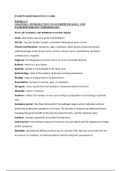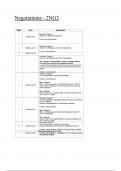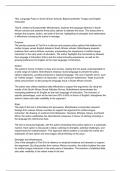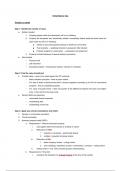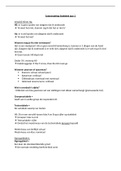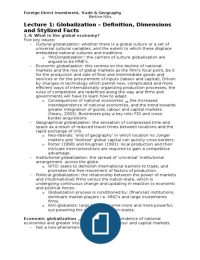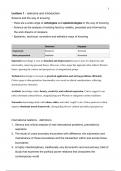Karien Snyman
Student number – 63330377
MAE201M
Unique number – 730374
Assignment 02
DECLARATION
I, KARIEN SNYMAN (Name & Surname)
Student number: 63330377
Module code: MAE201M
Hereby declare the following:
- I understand UNISA’S policy on plagiarism.
- This assignment is my original work produced by myself.
- I have duly acknowledged all other people’s work (both
electronic and print) through the proper reference techniques as
stipulated in this module.
- I have not copied work of others and handed it in as my own.
- I have also not made my work available to any fellow students to
submit as their own.
Signature: K. SNYMAN
Date: 2021-07-13
Page | 1
,Index:
Question 1: Page 3 – 4
Question 2: Page 5 – 7
Question 3: Page 8
Question 4: Page 9
Question 5: Page 10 – 11
Question 6: Page 12
Question 7: Page 13
Question 8: Page 14 – 15
Question 9: Page 16 – 20
Question 10: Page 21 – 23
Question 11: Page 24 – 35
Bibliography: Page 35
Page | 2
,Question1:
1.1. • Point 1: School algebra develops out of arithmetic.
Specific calculations like subtraction and addition are done using numbers. For each of
these numbers, symbols or numerals are used and each numeral has a specific
meaning, one numeral cannot be used for another number.
• Point 2: Word problems can be represented by means of informal/formal
mathematical symbols.
Learners can use algebraic thinking and express a word problem in a symbolic form.
• Point 3: We can think of algebra as generalized arithmetic.
When learners can recognise a pattern by seeing that something is the same. When
learners continue doing this, they can generalise the pattern and use words to explain
what is happening.
• Point 4: Algebraic thinking involves recognizing relationships between numbers.
When learners can see the relationship between number and describe said relationship
and they later use formal algebraic symbols to express relationships.
1.2. Point 1:
Taking the sentence “nine plus eight is equal to seventeen” and using numbers and
symbols to express it – 9 + 8 = 17
Point 2:
Taking a word problem like, “Sally and John both receive pocket money. Altogether they
receive R540. If John receives R250, how much pocket money does Sally receive?” and
expressing it in symbolic form:
☼ + 250 = 540
Later on, learners then express it in algebraic notation:
𝑥 + 250 = 540
Point 3:
Young learners can see a pattern when doing addition for example,
9 + 5 = 14 5 + 9 = 14
9 + 6 = 15 6 + 9 = 15
9 + 7 = 16 7 + 9 = 16
Learners will soon recognise a pattern and see that something is the same and say that
“the answer will stay the same regardless of the order in which any two numbers are
added together.”
They can later express it like a + b = b + a or ☼ + ♥ = ♥ + ☼
Point 4:
When learners are given different numbers in pairs like,
1 and 3, 2 and 4, 3 and 5… etc
Learners must be able to see the relationships between the numbers in each group and
later express it in algebraic notation.
The second number is the first number plus 2.
Make the first number x and the second number y,
𝑥+2=𝑦
Page | 3
, 1.3. In arithmetic thinking, the focus is on solving a problem and deals with the basic
computation of numbers by using operations like addition, multiplication, division and
subtraction. Arithmetic thinking is usually associated with elementary school mathematics.
For example, 7+4=11
In algebraic thinking, the focus is on representing a problem using numbers and variables.
It is usually associated with high school mathematics.
For example, a+b=c
Arithmetic shows regularity whereas algebra would give an expression to define these
patterns based on the regularities.
Example, in Arithmetic it we see,
1+0=1
1+1=2
1+2=3
1+3=4
In algebra we express the pattern with the rule 1+x
Page | 4
Student number – 63330377
MAE201M
Unique number – 730374
Assignment 02
DECLARATION
I, KARIEN SNYMAN (Name & Surname)
Student number: 63330377
Module code: MAE201M
Hereby declare the following:
- I understand UNISA’S policy on plagiarism.
- This assignment is my original work produced by myself.
- I have duly acknowledged all other people’s work (both
electronic and print) through the proper reference techniques as
stipulated in this module.
- I have not copied work of others and handed it in as my own.
- I have also not made my work available to any fellow students to
submit as their own.
Signature: K. SNYMAN
Date: 2021-07-13
Page | 1
,Index:
Question 1: Page 3 – 4
Question 2: Page 5 – 7
Question 3: Page 8
Question 4: Page 9
Question 5: Page 10 – 11
Question 6: Page 12
Question 7: Page 13
Question 8: Page 14 – 15
Question 9: Page 16 – 20
Question 10: Page 21 – 23
Question 11: Page 24 – 35
Bibliography: Page 35
Page | 2
,Question1:
1.1. • Point 1: School algebra develops out of arithmetic.
Specific calculations like subtraction and addition are done using numbers. For each of
these numbers, symbols or numerals are used and each numeral has a specific
meaning, one numeral cannot be used for another number.
• Point 2: Word problems can be represented by means of informal/formal
mathematical symbols.
Learners can use algebraic thinking and express a word problem in a symbolic form.
• Point 3: We can think of algebra as generalized arithmetic.
When learners can recognise a pattern by seeing that something is the same. When
learners continue doing this, they can generalise the pattern and use words to explain
what is happening.
• Point 4: Algebraic thinking involves recognizing relationships between numbers.
When learners can see the relationship between number and describe said relationship
and they later use formal algebraic symbols to express relationships.
1.2. Point 1:
Taking the sentence “nine plus eight is equal to seventeen” and using numbers and
symbols to express it – 9 + 8 = 17
Point 2:
Taking a word problem like, “Sally and John both receive pocket money. Altogether they
receive R540. If John receives R250, how much pocket money does Sally receive?” and
expressing it in symbolic form:
☼ + 250 = 540
Later on, learners then express it in algebraic notation:
𝑥 + 250 = 540
Point 3:
Young learners can see a pattern when doing addition for example,
9 + 5 = 14 5 + 9 = 14
9 + 6 = 15 6 + 9 = 15
9 + 7 = 16 7 + 9 = 16
Learners will soon recognise a pattern and see that something is the same and say that
“the answer will stay the same regardless of the order in which any two numbers are
added together.”
They can later express it like a + b = b + a or ☼ + ♥ = ♥ + ☼
Point 4:
When learners are given different numbers in pairs like,
1 and 3, 2 and 4, 3 and 5… etc
Learners must be able to see the relationships between the numbers in each group and
later express it in algebraic notation.
The second number is the first number plus 2.
Make the first number x and the second number y,
𝑥+2=𝑦
Page | 3
, 1.3. In arithmetic thinking, the focus is on solving a problem and deals with the basic
computation of numbers by using operations like addition, multiplication, division and
subtraction. Arithmetic thinking is usually associated with elementary school mathematics.
For example, 7+4=11
In algebraic thinking, the focus is on representing a problem using numbers and variables.
It is usually associated with high school mathematics.
For example, a+b=c
Arithmetic shows regularity whereas algebra would give an expression to define these
patterns based on the regularities.
Example, in Arithmetic it we see,
1+0=1
1+1=2
1+2=3
1+3=4
In algebra we express the pattern with the rule 1+x
Page | 4

